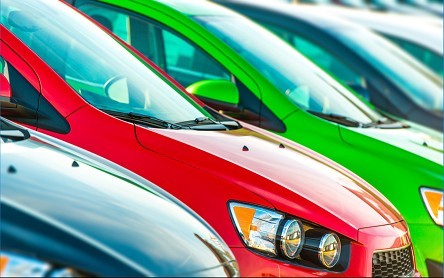Your brand new car just got hit in the parking lot, and its entire left side looks like cottage cheese! Your vehicle's paint is fairly uncommon, so the first thing you worry about is can a body shop match the color?
Don't fret quite yet. Now, thanks to new technology and better products in the automotive paint industry, collision repairers are more adept at matching your car's color than ever before. Whether your vehicle is painted in Tasman Green, Iridium Silver, Blu Netteno or Detonator Yellow, a reputable body shop worth its weight in basecoat should be able to seamlessly dial in your color and hue.
The problem is, body shops are great at painting an entire car. When they have to paint just a small section of your vehicle, it all gets more complicated: matching paint colors is much easier said than done. Certain vehicles feature custom paint jobs, making it even more difficult to find the perfectly matcing color. In the old days, dialing in the precise color was a hit-or -miss process. Thankfully, times have changed, and with today's technology to help them, it’s possible to match almost any car’s paint color, and achieve flawless results.
The Spectrophotometer
To strip the guesswork out of covering up a scratch or dent, skilled collision repair technicians need to find a replicated paint color. Without a matching shade for reference, a technician’s work will look sloppy, and sometimes even worse than an actual scratch or ding would. People with older, classic cars run into this dilemma frequently, especially when the manufacturer has discontinued a particular color.

To locate a matching paint color for a damaged car, technicians use a special device called a spectrophotometer. This device allows them to correctly identify the vehicle’s current shade. It does this by measuring the amount of light in conjunction with the exact hues on the vehicle’s current paint finish. This information is then paired with the vehicle’s VIN number to electronically locate the precise paint formula on the car's existing finish.
Through a computerized measuring system, the paint color is then replicated and applied over the damaged area of the car. If it's done right, the finished product will look brand new, with paint that matches the original color perfectly. Unfortunately, that’s much easier said than done!
The paint products used on today’s automobiles present a whole set of special challenges to color monitoring, and necessitate sophisticated instruments and methods to ensure accuracy and uniformity. Integrating innovative spectrophotometric technologies in car production lines can guarantee bumper-to-bumper color consistency, and allow for accurate measurements, even when working with complex materials.
Some paint formulas are especially susceptible to inaccuracy. Take for example any metallic or pearlescent paints. These formulations contain flakes of mica and aluminum to generate different color perceptions based on the viewing angle. In order to compensate for the changing nature and high reflective nature of metallic paints, multi-angle spectrophotometers are called upon to measure color at multiple angles and generate reliable readings based on complete spectral information.
Spectrophotometric devices can also be calibrated to ensure the correct measurement of non-metallic, high-gloss paints with significant levels of spectral reflectance. By carefully monitoring the color of each component and ensuring that all of the individual parts hold fast to the set standard, car manufacturers can create visually beautiful colors that match the existing paint when they are repaired after an accident.
Emerging Technology in Collision Repair

The spectrophotometer is one of the many cutting-edge technologies used by collision paint professionals. With the assistance of cameras and computers, technicians in body shops all over the country can now work with much more accuracy. While useful for matching automotive paint colors, this technology also assists technicians with consistency, and helps them return cars to their owners looking better than they did before.
With new technology becoming part of the world of collision repair every day. Color matching has entered the new age and enabled technicians to complete jobs quickly and and with more precision than ever before. It's a good thing too, because with more vehicles getting into millions of accidents every year, color matching has become a huge part of the overall repair process. Now, shops can ensure they’re generating a beautiful finished product time and time again.


